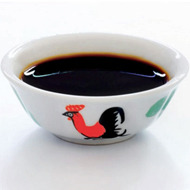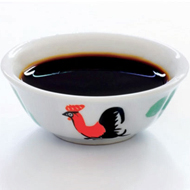5 Essential Japanese Dishes To Know
We may receive a commission on purchases made from links.
Japanese cuisine has become extremely popular here in the United States, as it is known for its refined, simple flavors, and ingredient-driven focus. Sure, it's easy enough these days to pop into the local sushi joint for a quick and delicious meal or pick up the phone and order some Japanese takeout, but why not save some money and try making Japanese cuisine at home? It's easier than one might think at first, and if you're equipped with the right pantry ingredients and a few simple recipes, Japanese cuisine can become accessible enough to incorporate into the weeknight meal routine.
So we spoke with Namiko Chen, author of the popular and critically acclaimed food blog Just One Cookbook, who offered a great deal of helpful insight into the essentials, including what dishes to try first, what ingredients to have on hand, what special techniques are needed, as well as some shortcuts. So without further ado, here's some great advice from Chen.
For someone who is new to Japanese cuisine, what five dishes would you suggest cooking?
Since this is for someone new to Japanese food, I picked five dishes that are popular and fairly easy to cook:
Teriyaki chicken is one of the most popular Japanese dishes in the U.S. Ready-made "teriyaki sauce" is usually available in nearby supermarkets. Interestingly, teriyaki is actually a cooking technique, not the name of the sauce: teri means "luster," in reference to the sweet soy sauce marinade and yaki means "grilling." The Japanese cook all kinds of meat, seafood, and vegetables with this cooking method. Since the taste is sweet and savory, these dishes are usually a hit with children as well.
Gyoza was derived from Chinese pot stickers, but the skin is thinner and they're usually smaller in size. Nowadays you can buy packages of frozen gyoza from supermarkets, but it's actually more fun to make your own with family and friends. Also, it can be pretty versatile, as you can put your own leftover ingredients from the fridge or you can make it with just veggies (usually it has pork in it). For a snack or appetizer, you can use leftover gyoza skins to make cheese wraps as well.
The California roll is probably one of the most well-known sushi rolls served in Japanese restaurants around the world. The ingredients are easy to find since you just need crabmeat (real or artificial), Japanese mayonnaise, dried seaweed, and sushi rice. Sushi rolls (makimono) are fairly easy to make and they can be a great finger food, appetizer, or party food.
 Donburi (rice bowl dish) is an economical, fulfilling, and quick and easy meal. It is my go-to menu item when I don't have much time to prepare a full meal for my family. The most common donburi include gyudon (beef donburi), oyakodon (chicken and egg donburi), katsudon (deep-fried cutlet and egg donburi), unadon (grilled eel donburi), and more.
Donburi (rice bowl dish) is an economical, fulfilling, and quick and easy meal. It is my go-to menu item when I don't have much time to prepare a full meal for my family. The most common donburi include gyudon (beef donburi), oyakodon (chicken and egg donburi), katsudon (deep-fried cutlet and egg donburi), unadon (grilled eel donburi), and more.
Lastly, when you serve a bowl of rice in Japan, you must accompany it with miso soup. Here in the U.S., Japanese restaurants serve miso soup at the beginning of the meal, but in Japan it's usually served with the meal. Miso soup in the U.S. only contains green onion and a few pieces tofu or seaweed, but in Japan there are a variety of miso soups with different kinds of miso and ingredients (pork, clam, seafood, etc.).
Click here to see the Adzuki Bean-Miso Soup Recipe.
What are the ingredients a cook should keep in the pantry (and in the fridge) that are essential to many Japanese dishes?
I consider the following items essential for most Japanese cooking:
Photo courtesy of Veer/Kia Cheng Boon)
Photo courtesy of Wikimedia/KVDP)
Ozeki, Gekkeikan, or Sho Chiku Bai (or use leftover good-quality sake, too) would be fine. The closest substitute would be dry sherry, although it's not the same. (Photo courtesy of flickr/sally_monster)
Photo courtesy of flickr/pinprick)
Rice vinegar is made from rice, and it is sweeter, milder, and less acidic than white vinegars. It is known for its antibacterial properties and it's an essential ingredient in sushi rice. You can substitute with white-wine vinegar or apple cider vinegar; however, non-Japanese vinegars have a strong vinegar taste, so add a little sugar and water to make it milder.
Nowadays most of these ingredients can be found in the Asian aisle at supermarkets, but for some ingredients you might need to check your local Japanese or Asian market. Whole Foods or other premium supermarkets also carry some difficult-to-find products. You can also order online at Amazon or Japanese supermarkets Mitsuwa and Marukai.
What are some techniques that cooks should be familiar with to be successful with Japanese cooking?
I'd like to introduce two techniques that the Japanese use often for cooking. First, we always skim off the scum and fat when making soups and stocks. It is quite a bit of extra work but it's the key for the refined taste and it is required to keep the soup/stock liquid clear.
Secondly, we use an otoshibuta (a drop lid) for simmering food. The drop lid ensures that the heat is evenly distributed so that the ingredients cook quickly and evenly. The cooking liquid circulates toward the lid and coats the top of the ingredients without stirring. Also, the drop lid holds ingredients in place so that they don't move around and break apart.
Can you describe the typical flavor profiles in Japanese cuisine?
Traditional Japanese cuisine is all about simplicity of the dish and using seasonal and fresh ingredients to create harmony.
Simplicity lets the food speak for itself. The Japanese believe that if the dish is prepared with quality, fresh ingredients, then there isn't the need to add many flavors. The rule of thumb is not to kill the natural flavor of the food and include seasonal ingredients, as we have four distinct seasons in Japan.
We think about "harmony" (wa) when preparing each dish and meal. The ingredients must be in harmony together to make one dish, and the dish must be in harmony with other dishes to make a meal. Color, texture, and flavor are some of the important elements when considering harmony.
Are there any shortcuts you use on a day-to-day basis?
dashi stock (as you would use chicken, beef, or vegetable stock for Western meals). I either prep a large amount of dashi stock in advance (store in the refrigerator to use over several days) or I use a convenient dashi packet, which can be prepared in a short time. I consider this method better than dashi granules/powder (some brands contain MSG, but there are MSG-free versions available). (Photo courtesy of Wikimedia/Franzeska)
Is there anything else you think TDM readers should know?
Japanese cuisine is considered to be one of the world's healthiest cuisines due to its low-fat content and small portions. It is nutritionally well-balanced, light, and healthy, which is one of the reasons for the longevity of the Japanese population. The diet is very low in cholesterol, fat, and calories, and high in fiber. I hope more people become more interested in cooking Japanese food and live happily and healthily.
Will Budiaman is the Recipe Editor at The Daily Meal. Folllow him on Twitter @WillBudiaman.

